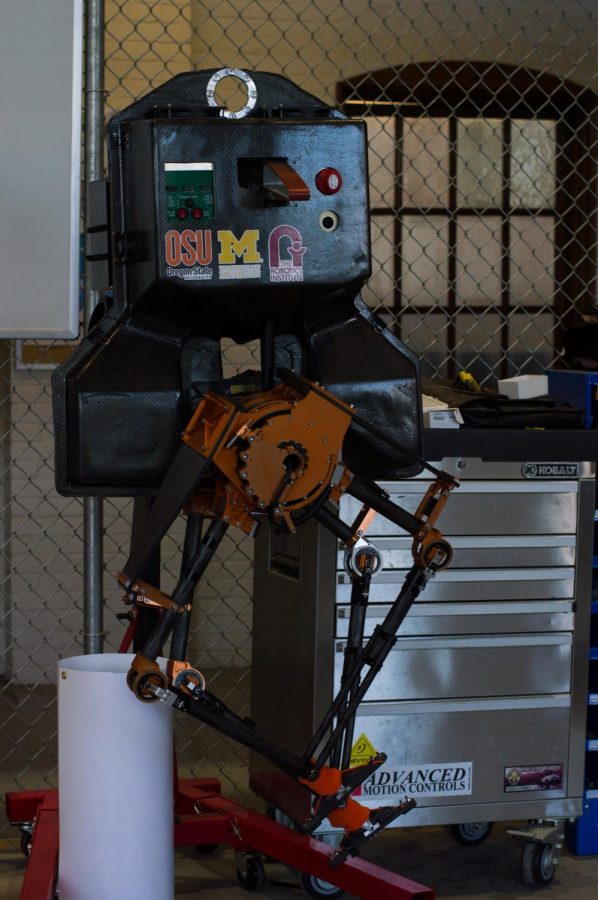Oregon State University Robotics program a step ahead of the rest
May 26, 2016
Program receivingnational attention, continues research
The Oregon State University Robotics program is stepping into the spotlight and gaining national recognition.
Currently stationed in Graf Hall, the Robotics program has ongoing research on spider robots that sense vibrations, autonomous research vessels, self-driving wheelchairs and more.
These projects, along with the dedicated staff, has led an organization called Grad School Hub to place OSU at the top of the list for robotics programs in the western United States, and at number four when the entire nation is taken into account.
“That ranking, for us, is an opportunity, as well as kind a warning” said Jonathan Hurst, the College of Engineering Dean’s Professor. “There are a lot of robotics programs that are growing and starting all over the country. There are a lot of places throwing a lot more resources behind it than Oregon State can.”
Hurst was one of the original members of the faculty involved in the Robotics program, and one of currently 11 faculty members in the program.
“Robotics is an enabling technology,” Hurst said. “By its nature, robotics is a collaborative thing. We work the with EECS, we work with Oceanography, we work all over the place.”
These collaborations, along with the commitment OSU students and staff are what has gained recognition from outside organizations, according to Hurst.
“We’ve got something special here. It has to do with the culture, it has to do with the grassroots growth of the robotics program, and how all of the faculty here are engaged together in the process of building something,” Hurst said.
According to Hurst, the first class of robotics students started in 2014. This program is one of only five graduate programs for robotics in the country, drawing in students and faculty from across the world.
The program is currently researching a handful of topics, according to Hurst. Hurst is personally working on walking and running machines.
One of these machines, given the name ATRIUS, has got some attention, according to Hurst. ATRIUS stands for “Assume The Robot Is A Sphere,” and is bipedal. The research aims to allow for bipedal robots to run on rough terrain, a difficult task for current machines.
Steph Walker, a second year Ph. D. student in the robotics program, is currently working on new, soft materials for robotics.
“We usually use silicones, I’m working in polyesters,” Walker said. “They’re stretchy, they’re plant based, and they are degradable. That’s valuable in terms of if you want a temporary robot, or if you are working in a medical context.”
One of the materials in the robotics lab is primarily made of three elements. Two of them are plant based, and the other is a food supplement. There are also biodegradable sensors so that researchers can gather data without having any dramatic impact on the environment.
“A lot of my work is focusing on green chemistry, integrated into the robotic world,” Walker said. “The sensors can be incorporated into a ‘soft robot.’ Soft robots you can imagine could be like an octopus, and would be outfitted with a power supply, a brain, and all sorts of sensors that, if you put it into the environment, would be able to interpret what it was seeing, make a decision, and act on it.”
Kory Kraft, a Ph. D. student in personal robotics has focused research on health care. The research focuses on autonomous and semi-autonomous robotic systems. These robots would take the place of some health care workers when dealing with infectious disease.
“The idea is to utilize robots’ inability to catch infectious diseases to provide quality patient care while still ensuring health care protection,” Kraft said.
baro.news@oregonstate.edu


















































































![Newspaper clipping from February 25, 1970 in the Daily Barometer showing an article written by Bob Allen, past Barometer Editor. This article was written to spotlight both the student body’s lack of participation with student government at the time in conjunction with their class representatives response. [It’s important to note ASOSU was not structured identically to today’s standards, likely having a president on behalf of each class work together as one entity as opposed to one president representing all classes.]](https://dailybaro.orangemedianetwork.com/wp-content/uploads/2025/03/Screenshot-2025-03-12-1.00.42-PM-e1741811160853.png)
























